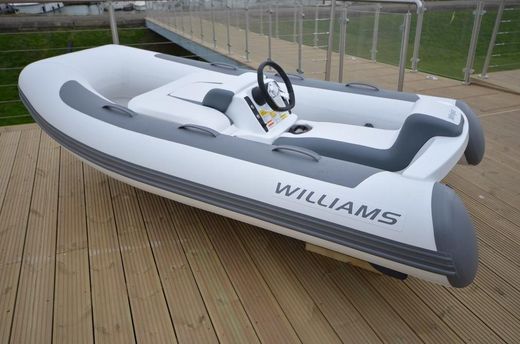HeadedToTexas
Guru
I saw a Williams jet RIB this week and read up on the idea, but found very little discussion here. While most seem over powered for tender duty, they seem ideal for the application. What are their shortcomings, if any?



I saw a Williams jet RIB this week and read up on the idea, but found very little discussion here. While most seem over powered for tender duty, they seem ideal for the application. What are their shortcomings, if any?

Weight?
The Williams Minijet 280 weighs 462 pounds.
There were/are members here, "B&B" that said they owned one. Maybe they will chirp up, or you can do a search and find their discussions of same. Seemed to be very happy with it.
Little inboards crammed in a humid engine box. Life expectancy is not too long, and not easy to work on.
An outboard dies and it can be fixed in 15 minutes. Just stick another one on.
My understanding is that jet drives do not last long in salt water. Just my recollection.
Like everything a jet RIB has its pros and cons as a tender.
I bought a second-hand Avon Seasport 320 12 years ago or so and I still have it. It is 10' long, weighs 550 lbs. and packs an 80 hp 2-stroke Yamaha engine and jet drive.
At the time I wanted a dinghy that could also be used to take my children water-skiing but was small enough to be able to carry on the roof of the aft-cabin of my then boat a Grand Banks 42 Classic. Concerned about safety for the children, my wife valued a jet drive.
So I located and bought a second-hand jet (new ones are prohibitively expensive at $20k to $30k), installed a pipe davit and off we went.
I have used it for many years and have come to appreciate its advantages but admit it has some disadvantages compared to an outboard dinghy.
The main things I like about it are:
- wickedly fast acceleration and top speed of around 30 knots, which seems twice as fast in such a little thing so close to the water;
- no need to worry about hitting anything with the prop when coming ashore or having to raise the engine out of the water;
- safety when using with people in the water
- huge power and capacity in a very compact package: It would (just about) plane with me, my wife our three children and our two Labradors;
- easy to dock the mother ship while towing the RIB as there are no hard bits sticking out that can cause damage by hitting the boat or other boats.
- quite simple mechanically: there is no transmission with the turbine directly connected to the engine's output shaft and neutral and reverse achieved by orienting a scoop that will cover the jet nozzle; there is no water pump either, with high-pressure cooling-water simply drawn through the turbine casing.
The main disadvantages I found are:
- more expensive than similarly sized conventional dinghy
- quite heavy: when taking it to shore I would need anchor (with a clothes-line set-up) rather than simply pulling it up on to the sand;
- very hard to do work on the engine as it is hard to reach, at least in my jockey-seat model;
- very inefficient in terms of fuel consumption, probably in part because of the older 2-stroke engine but, I am guessing, the jet drive as well.
In terms of manoeuvrability I found it is actually superior. It behaves very different to an outboard-driven dink and so initially it appears to have terrible manoeuvrability. But after using several times one gets the hang of it and can dock it more elegantly than a conventional dinghy. It will, for example, turn around in place with no forward motion.
It is now almost 20 years old and I am not fully confident to take it longer cruises. My main dinghy now is a 13' Boston Whaler with a 40 HP outboard that I tow. That is also an awesome tender.
My understanding is that jet drives do not last long in salt water. Just my recollection.
The low speed handling is very poor, IMHO. As you approach the transom on your (real) boat, it is a complete lottery whether you will reach the desired location gently, or not at all, or in a manner/speed that will damage something. Over time, it turns into a real pain in the arse and you then go and buy a ‘conventional’ tender with an outboard.
H.
I had a Novarania 24 with a yanmar engine and a hamilton jet drive. Once you learn to handle them they are EXTREAMLY maneuverable at low speed. Trick is to keep the rpms up and use the bucket to control speed. I could come into a slip just a bit wider than my length, do a slow180 turn in place and head back out fully under control, just keep the throttle up, same with laying alongside. VERY MANEUVERABLE. Much more so than a tender with an outboard.
Pros were maneuverability, ability to go thru ice, no prop dings, would handle a good load, simple operation, can land on the beach.
Cons, heavy, sand tends to wear the drive when you do a lot of beach landings, slow acceleration if pulling skiers out of the water.
Otherwise. Great tender.
M
